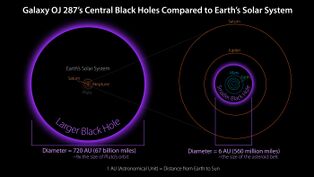Astronomy:Ultramassive black hole

An ultramassive black hole (UMBH or sometimes UBH) is the largest type of observed black holes, with mass at least 10 billion times the mass of the Sun (M☉).[1][2] It is even more massive than supermassive black hole, but some astronomers consider it just a supermassive black hole too. It was previously thought that their mass cannot exceed 50 billion M☉,[3] but still even more massive black holes (such as Ton 618 with 66 billion M☉) were discovered.[4] Although there are also more massive types of black holes, there is currently no evidence that they exist.[5]
Most of these are associated with exceptionally energetic quasars.
Occurrence
Ultramassive black holes are usually found in giant elliptical or lenticular galaxies, such as Messier 87. However, the black hole at the center of M87 galaxy has a mass of "only" 6.5 billion M☉, so it is not ultramassive.[6] A typical example of a galaxy with an ultramassive black hole is the supergiant lenticular galaxy IC 1101, at the center of which is a black hole with a mass of over 50 billion M☉.[7] In general, the bigger the galaxy, the larger the black hole at its center.[8]
References
- ↑ Irving, Michael (February 21, 2018). ""Ultramassive" black holes may be the biggest ever found – and they're growing fast". News Atlas (GIZMAG PTY LTD). https://newatlas.com/ultramassive-black-holes/53493/.
- ↑ From Super to Ultra: Just How Big Can Black Holes Get? | NASA
- ↑ Sokol, Joshua. "Black holes have a size limit of 50 billion suns" (in en-US). https://www.newscientist.com/article/dn28647-black-holes-have-a-size-limit-of-50-billion-suns/.
- ↑ Shemmer, O.; Netzer, H.; Maiolino, R.; Oliva, E.; Croom, S.; Corbett, E.; di Fabrizio, L. (2004). "Near-infrared spectroscopy of high-redshift active galactic nuclei: I. A metallicity-accretion rate relationship". The Astrophysical Journal 614 (2): 547–557. doi:10.1086/423607. Bibcode: 2004ApJ...614..547S.
- ↑ "'Stupendously large' black holes could grow to truly monstrous sizes" (in en). 2020-09-18. https://www.space.com/black-holes-can-reach-stupendously-large-sizes.html.
- ↑ "M87 | Black Hole, Distance, & Facts | Britannica" (in en). https://www.britannica.com/place/Virgo-A.
- ↑ "IC 1101: One of the Largest Galaxies Known – Constellation Guide". https://www.constellation-guide.com/ic-1101/.
- ↑ "Massive Black Holes Dwell in Most Galaxies, According to Hubble Census" (in en). http://hubblesite.org/contents/news-releases/1997/news-1997-01.

